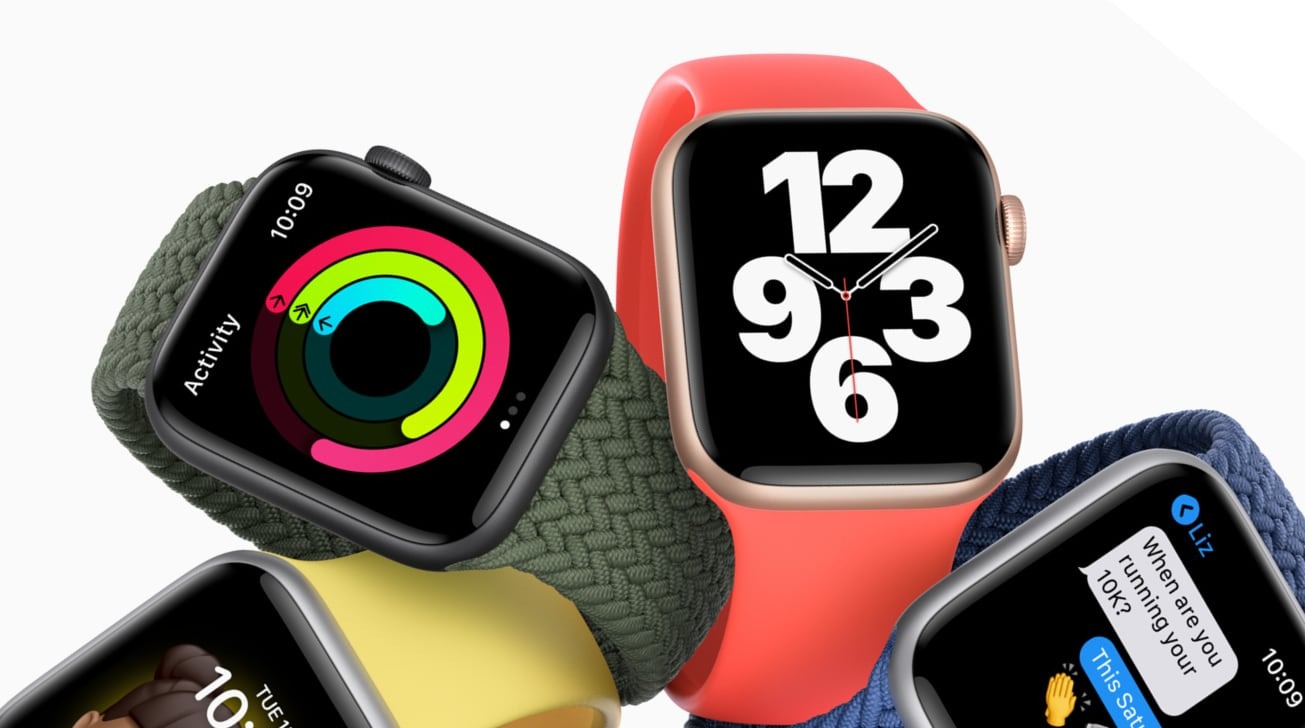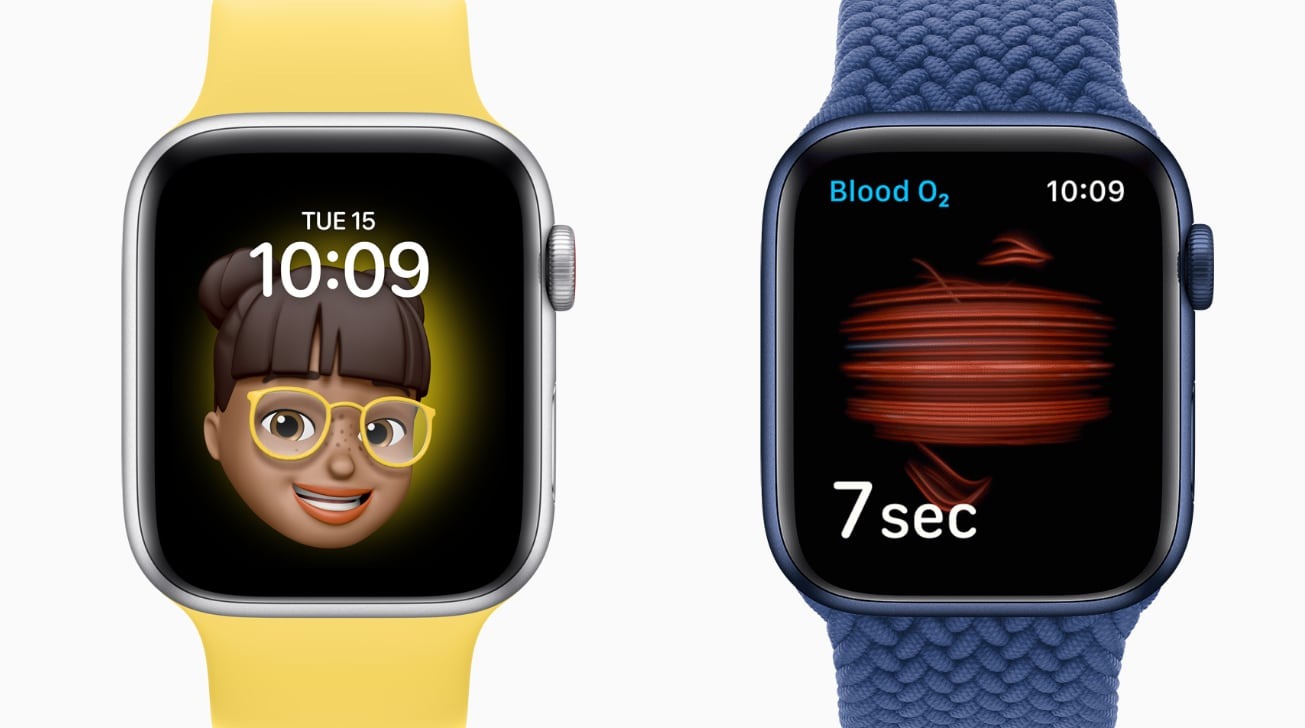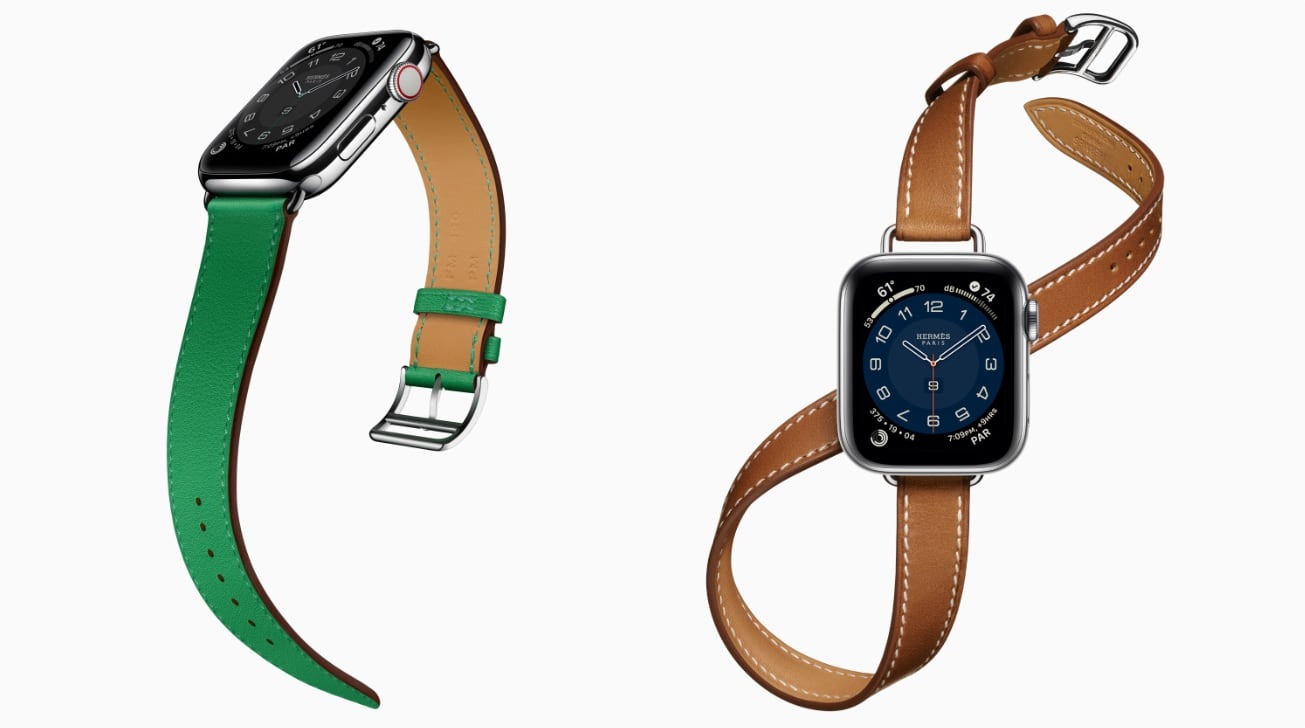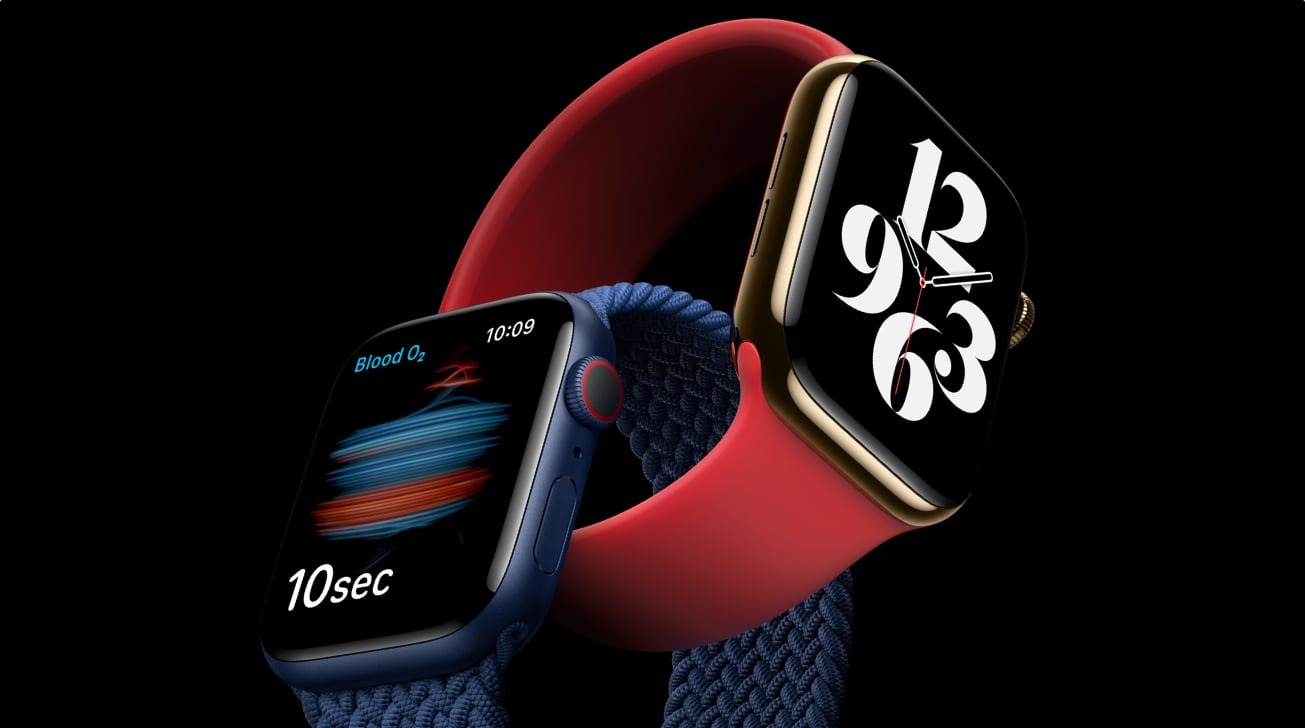The Apple Watch Series 6 with its blood oxygen monitoring is joined at launch by the Apple Watch SE, but are either enough to tempt existing Series 5 users? Here's the upgrade breakdown, by the numbers.
Part of Apple's annual fall product line refresh, the Apple Watch Series 6 takes over from the Apple Watch Series 5 as the highest-specification model. In this year's implementation, Apple has added blood oxygen sensing, which could be a considerable benefit for some users.
However, the upgrade may not necessarily be enough for existing owners of the Apple Watch Series 5 to make the upgrade to the latest edition.
Furthermore, the introduction of the Apple Watch SE also gives users another upgrade option, or a potentially more viable entryway to Apple Watch ownership.
Before their release, the best way to assess the new models is to compare them against the previous generation.
Apple Watch Series 6 vs Apple Watch SE vs Apple Watch Series 5 - Specification
| Apple Watch Series 6 | Apple Watch SE | Apple Watch Series 5 | |
|---|---|---|---|
| Price (starting) | $399 Lowest Apple Watch 6 prices | $279 Lowest Apple Watch SE prices | $399 Lowest Apple Watch 5 prices |
| Sizes | 40mm, 44mm | 40mm, 44mm | 40mm, 44mm |
| Display | Always-On Retina | Retina | Always-On Retina LTPO OLED |
| Case Materials | Aluminum, Stainless Steel, Titanium | Aluminum, | Aluminum, Ceramic, Stainless Steel, Titanium |
| Processor | S6 | S5 | S5 |
| Heart Sensor | Blood Oxygen Sensor With ECG | Second-generation optical heart sensor | Second-generation optical heart sensor with ECG |
| Water Resistance | 50m | 50m | 50m |
| Battery Life | Up to 18 hours | - | Up to 18 hours |
| Recharging | Wireless | Wireless | Wireless |
| Connectivity | Wi-Fi, Bluetooth 5.0 | Wi-Fi, Bluetooth 5.0 | 802.11n 2.4GHz, Bluetooth 5.0 |
| Other Sensors | GPS Compass Barometric altimeter Accelerometer Gyroscope Ambient light sensor | GPS Compass Barometric altimeter Accelerometer Gyroscope Ambient light sensor | GPS/GNSS, Compass Barometric altimeter, Accelerometer, Gyroscope, Ambient light sensor |
Apple Watch Series 6 vs Apple Watch SE vs Apple Watch Series 5 - Case sizes
Since the introduction of the Apple Watch Series 4, Apple has offered the Apple Watch in a choice of two sizes, described as 44mm and 40mm cases. The number refers to the length of the device, and is largely an indicator of how much bigger one size is over the other.
The two sizes of Apple Watch Series 6 and Apple Watch SE next to an iPhone running Family Setup.The Series 5 measures 40mm by 34mm for the smaller model, and 44mm by 38mm for the larger version. Both have the same thickness of 10.74mm.
Apple has yet to offer details about the physical dimensions of the new models, except they will be offered in 40m and 44mm versions. This suggests there won't be much else in the way of changes to the general sizes, though thickness may still be a factor given the use of a new sensor.
Apple Watch Series 6 vs Apple Watch SE vs Apple Watch Series 5 - Materials and weight
One of the biggest variables of how heavy an Apple Watch is to wear is the material it is produced from. As each are made from a number of different substances, as well as the varying dimensions of each size, there's quite a variety of different sizes at play for the wearable device.
The Series 5 is offered in four different materials for the GPS + Cellular model, consisting of aluminum, ceramic, stainless steel, and titanium. The GPS-only model is provided in just one material, aluminum, which is also the lightest of the four materials at 30.8 grams for the 40mm model, 36.5 grams for the 44mm.
While Apple hasn't offered information about the weights of each of the cases, it has confirmed the Series 6 will be provided in three materials, with aluminum, stainless steel, and titanium being used, while ceramic won't be sold this year. The variants should be in the same ballpark as the Series 5 for their respective weights, given their similar styling and sizes.
The Apple Watch SE was expected in plastic, but is only available in aluminum. This is to be expected for the value-oriented device. While the internals will be different, it should still be quite close to the aluminum versions of the other two models.
Expect differences here in terms of fractions of a gram. For the vast majority of users, it probably won't matter a single bit.
Apple Watch Series 6 vs Apple Watch SE vs Apple Watch Series 5 - Display
In the move from the Series 4 to the Series 5, Apple's main improvement to the model was the display, which was the same low temperature poly-silicon and oxide (LPTO) OLED Retina display as the previous model. It had the same resolution as its predecessor, at 324 by 394 or 368 by 448 depending on the model, as well as Force Touch support and 1,000 nits of brightness, but there was an important change to how it worked.
By altering the pixel architecture, Apple was able to reduce the refresh rate of the display down from 60Hz to as low as 1Hz. When combined with a low-power driver, upgraded power management, and a better ambient light sensor, the screen was able to be on all the time, rather than requiring users to flick the wrist to wake it up.
The Apple Watch Series 6 keeps the always-on display. The Apple Watch SE doesn't have it.As the Apple Watch Series 6 is effectively using the same display as the Series 5, there's no real change here at all. There is a change, however, in that the always-on screen is now 2.5 times brighter outdoors when the user's wrist is down.
The Apple Watch SE doesn't have an always-on display, with users having to raise their wrist to wake the display. Given this is a reversion to the system used in the Apple Watch Series 4 while using the same-sized display, it is probable that Apple is reusing the design of the Series 4 display in the SE.
Apple Watch Series 6 vs Apple Watch SE vs Apple Watch Series 5 - Processing
For the Apple Watch Series 5, Apple used the S5 64-bit dual-core processor, which boasted a higher level of performance than the S4 used in the Apple Watch Series 4. The Apple Watch SE uses the same S5 chip, which will make it comparatively similar to the Series 5 for performance.
The Series 6 uses the S6 System-in-Package, which runs up to 20% faster than the S5. Apple claims this will mean apps will launch 20% faster than before.
The Apple Watch SE uses the S5 chip, while the Series 6 uses the 20% faster S6.The nature of smart watches means it is extremely unlikely that any major processing will take place on an Apple Watch at all, with the toughest tasks likely to revolve around media playback and user interface rendering. While this could change in the future, with users able to directly install apps via the watchOS App Store, it is likely that all users will see are more seamless animations from the interface and faster app launch times.
The Apple Watch Series 6 has the U1 ultra wideband chip. It is the first Apple Watch to have one.
Apple Watch Series 6 vs Apple Watch SE vs Apple Watch Series 5 - Storage
The Apple Watch Series 5 offered an upgrade of onboard storage for users, from 16 gigabytes in the Series 4 to a more considerable 32 gigabytes. This meant more songs and podcasts could be stored on the wearable device for workouts, saving users from having to bring along and risk damaging their linked iPhone.
The storage capacity was also useful for those who used the dedicated watchOS App Store, as apps were being actively installed on to the Apple Watch, instead of users experiencing notifications on the Apple Watch while the main processing took place on their iPhone.
The Apple Watch Series 6 has 32GB of storage. It isn't yet clear how much the Apple Watch SE has.
Apple Watch Series 6 vs Apple Watch SE vs Apple Watch Series 5 - Healthcare
The Apple Watch Series 5 uses the same second-generation optical heart sensor on the back of the device as was introduced in the Apple Watch Series 4. As well as providing the ability to monitor a pulse, electrodes that also connected to the Digital Crown allowed users to perform an electrocardiogram whenever they wanted.
The Blood Oxygen sensor in the Apple Watch Series 6For the Series 6, Apple has moved to provide a new metric to monitor: blood oxygen levels. This statistic is useful to know for people with breathing difficulties and heart conditions, such as asthma or chronic obstructive pulmonary disease.
The sensor on the back uses a combination of red, green, and infrared light on the skin to monitor blood oxygen levels. The related app is able to perform the test in just 15 seconds, half the time it takes to perform an ECG test.
The Apple Watch SE doesn't offer either ECG or blood oxygen monitoring, but is still capable of recording pulse rates and general movements.
Apple Watch Series 6 vs Apple Watch SE vs Apple Watch Series 5 - Battery
The Series 5 offered the same claimed battery life as the Series 4, in having 18 hours of usage. This was largely due to a combination of savings from improved power management, and the decision to have an always-on display balancing each other out.
The Series 6 offers the same battery life, despite providing a generally brighter always-on display. It is unclear if this is to having a larger battery, power efficiency savings, or both elements changing.
Apple didn't go into detail about the Apple Watch SE's power capabilities, but it is likely to be in the same range of battery life.
Recharging for all models continues to involve the use of Apple's wireless charging puck, making the Apple Watch Series 6 compatible with all earlier Apple Watch charging stands and power accessories.
Apple won't be including a charger with the new Apple Watch models, so users will have to find their own power brick.
Apple Watch Series 6 vs Apple Watch SE vs Apple Watch Series 5 - Other features
There's a long list of other features and specifications that are making a reappearance in the move to the Series 6. That includes its water resistance to 50 meters, the compass, and a smattering of other sensors used to monitor movements and extra useful details.
The altimeter for the Series 6 has been upgraded, so it now provides a real-time altitude down to the foot. For walkers and climbers, this is really handy data that's always on-hand.
The S6 is also capable of faster charging, with it capable of performing a full charge in under 1.5 hours. Battery life improvements are also claimed for tracking certain types of workout, including indoor and outdoor runs.
Apple Watch Series 6 vs Apple Watch SE vs Apple Watch Series 5 - Pricing
At launch, the Apple Watch Series 5 started from $399 for a 40mm aluminum case and either a basic Sport Loop or Sport Band. Changing it to the 44mm model raised the price to $429, while adding cellular connectivity brings the price up by $100.
On the other end of the price spectrum, a 44mm ceramic Apple Watch Series 5 with a Space Black Link Bracelet would set buyers back $1,749.
For the Apple Watch Series 6, the aluminum model costs $399 for the 40mm version, $429 for the 44mm with a Sport Loop, with cellular again pushing the price up by $100. A 44mm Space Black Titanium Case and Space Black Link Bracelet costs $1,249 at the other end of the scale, but a Stainless Steel 44mm case with a Hermes Ebene Barenia Leather Single Tour Deployment Buckle is more expensive at $1,499.
The Apple Watch SE costs $279 or $309 for the 40mm and 44mm GPS models respectively with a Solo Loop, but cellular is only an extra $50 on this model. It is possible to push the price up to $709 by adding a Space Black Link Bracelet, but at that point it would be worth considering buying a Series 6 instead of the SE.
Apple Watch Series 6 vs Apple Watch SE vs Apple Watch Series 5 - What to buy
In 2019, AppleInsider compared the Apple Watch Series 4 with the Series 5, and the two models were largely similar with relatively few changes. Even so, the always-on display was enough of a benefit to warrant an upgrade to anyone who was irked by having to wake the watch each time.
The deduction was also bolstered by the relatively high resale rates for the Apple Watch Series 4 at the time, making the overall cost of upgrading to the new model relatively low after both buying and selling transactions have occurred.
In comparing the Apple Watch Series 6 with the Series 5 at this early stage, it's a similar situation again. For people who need to know about their blood oxygen level, which is an important thing to know about during the ongoing COVID-19 pandemic as well as for athletes, the blood oxygen sensing makes the new model an appealing option.
For everyone else who owns a Series 5, there's not as much to really recommend upgrading to the 2020 model. The new additions are nice to have, but unless you can get a lot of money for the sale of the Apple Watch Series 5 to go towards the Apple Watch Series 6, it's probably not worth it.
Apple Watch Series 3 and Apple Watch Series 4 owners are probably the target market for the Apple Watch Series 6.
All that being said, it's a completely different ball game for the Apple Watch SE. As the new entry-level model, it provides most of the features of the full-priced stablemates, but at a more wallet-friendly price.
Sure, there's no Blood Oxygen app, nor is there ECG functionality, nor a real-time altimeter, but it still covers the vast amount of bases for people who desire the rest of the Apple Watch functionality.
The better question is whether the Apple Watch SE offers enough of an upgrade from the Apple Watch Series 3 to warrant the extra $80. Given it's got the bigger screen, the option for cellular connectivity, the better performance, support for Family Setup, and an element of future-proofing, there's still enough to warrant paying $279 for the Apple Watch SE instead of $199 for the aging Apple Watch Series 3.
The Apple Watch SE isn't an upgrade option at all, but it is a compelling entrypoint into wearable devices, especially for those who want their children to have one.
 Malcolm Owen
Malcolm Owen











-m.jpg)






 Christine McKee
Christine McKee

 Marko Zivkovic
Marko Zivkovic

 Andrew Orr
Andrew Orr
 Andrew O'Hara
Andrew O'Hara
 William Gallagher
William Gallagher





-m.jpg)



24 Comments
The SE seems to be an S5 with an S3's optical-only heart sensor and no compass. Like the iPhone SE, it's a scary awesome value.
Does the Apple Watch Series 6 support 5G? MmWave? WiFi 6?
If buying an Apple Watch the Series 3 to the SE should be a no brainier decision for pretty much everyone, you get so much more for that £70 and would have to be an absolute fool to pick up the ageing S3.
The jump from the SE to the Series 6 is a lot harder. £160 is quite a bit of money and the main core functionality is all present.
I’m probably going to go for the Series 6, I figure the extra money will buy me one more years worth of software updates and the fast charging and potential of the U1 chip appeal to me.